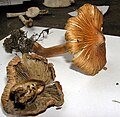Sections or subgenera
Source: [6]
Two supersections are informally recognized: [7] Cortinate supersection: The stipe is only pruinose at the apex or the upper half. The stipe base is (generally) not bulbous and a remnant of a cortina is present in the margin of the young cap. Marginate supersection: The stipe are entirely pruinose and has a bulbose base as general.
Several genera are recognized within the family Inocybaceae:
Inocybe
This subgenus has pleurocystidia, usually thick-walled and in the apex has crystals. The basidiospores are smooth or angular-nodulose. The basidia is not necropigmented (basidia that become ochraceous and collapse). The hilar appendice is conspicuous. This subgenera is cosmopolitan and frequent in temperate ecosystems.
Auritella
This subgenus has no pleurocystidia and has necropigmented basidia. The spores are smooth and the hilar appendix is inconspicuous. Large cheilocystidia (>50 um). This is known from tropical Africa, Tropical, India and temperate Australia.
Inosperma
The fruiting bodies of this subgenus usually have a distinct odor (fruity, honey-like, fishy). The pileus is radially rimose ("Rimosae") or can be squamulose to squarrose ("Cervicolores"). The lamella has no pleurocystidia, but has cheilocystidia. Basidia necropigmented or not. The spores are smooth. In temperate areas. Wide distribution.
Mallocybe
The cap is usually woolly-squamulose, the cap surface is conspicuously darkening with alkali. The lamella broadly adnate to subdecurrent. The stipe is shorter and has not pleurocystidia. The basidia are necropigmented and there are also cheilocystidia as terminal elements. Spores smooth. Wide distribution
Nothocybe
The lamellae have no pleurocystidia but there are cheilocystidia. Spores smooth. Known from tropical India.
Pseudosperma
Fruitbodies have indistinct, spermatic or green corn odor. The pileus is radially rimose or rimulose, never squarrulose and rarely squamulose. Pleurocystidia are absent and cheilocystida are present. Spores smooth. Wide distribution.
Tubariomyces
Small fruiting bodies with tubarioid or omphalinoid habit. Decurrent lamellae and cheilocystidia present. Spores smooth. Known from mediterranean and tropical Africa.




























